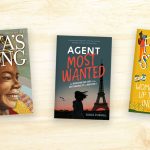As writer of fiction, I often wonder about the real-world impact of the stories I tell. Sometimes, when I read the news and pause to reflect on the ongoing struggles in so many parts of the world, or stop to think about the overwhelming array of worthwhile causes that need support, time, and resources, I wonder if storytelling is something of a luxury as opposed to a necessity. In many ways it is; however, having said that, I am also a passionate believer in the power of words to foster a greater sense of empathy and compassion in our complicated, beautiful world, and I do believe that if a story touches you, the reader, then there is no telling what might happen next.

For today’s blog post, I would like to share the gist of a letter I recently received from a retired teacher and librarian named Nancy, who lives in California. Nancy wrote that she had so enjoyed Wildoak, she decided to act in her own small way and do what she could to help the fight against climate change. As we all know, California has been hard hit in recent years with catastrophic flooding, wildfires, and drought, so this felt directly meaningful. Her birthday was coming up and she had looked up one of the organizations listed at the back of Wildoak, called One Tree Planted. Instead of asking for gifts, she requested that her family and friends come together and help her reach her goal of planting 62 trees, one for each year she was celebrating. In all honesty, this letter made me teary. Learning that my characters had so moved a reader living thousands of miles away was both humbling and inspiring. It felt as if Grandpa Fred’s words had somehow made it off the page and into the real world:
I really do believe that when lots of people, perhaps hundreds or even thousands of people do what they can, things really will change.”
I wonder if this is something that could translate well into the classroom? I wonder if there might be an opportunity to read the book’s epilogue out loud and then take a moment to think about what sort of cause might feel important to each of your students? What if students were to take a moment and think about something that they might like to change for the better… something local, something realistic, something they care about. Maybe they could design a poster and sketch out words and pictures, presenting a vision of what it is they would like to do. Nancy’s goal of 62 trees could easily be translated into the planting of 9, 10, or 11 trees.
Or maybe there are animal lovers in the class. What might one child be able to do that could possibly make a difference? It turns out that something as simple as fact-sharing can make a difference. Designing a poster detailing the challenges faced by snow leopards and putting it up in a local library or school hallway can make a difference. Awareness matters.
Or maybe it’s something closer to home. Whales, sea turtles, wolves, condors—each state faces differing challenges. Perhaps there is a particular species your students might relate to that feels real to them. Or maybe it is even simpler than that; just knowing the names of things can make a difference. There’s a moment in the book when Grandpa Fred talks about a type of butterfly local to Cornwall that was in danger of going extinct at the time. It is true that if we as human beings don’t know the names of things, we are much less likely to care or notice if they disappear. I quote the following from Dr. Jane Goodall in the epigraph:
Only if we understand, can we care. Only if we care, will we help… and only if we help, shall all be saved.”
If you have students who really want to get involved in the kind of work that Maggie ends up doing, perhaps you could also share with them details of Dr. Goodall’s organization Roots and Shoots. It is specifically set up to encourage young people to make positive changes in their local communities and it offers grants to help them do just that.
Perhaps I am something of an idealist; but perhaps there is a need for idealists. And perhaps we need our children and young people to know that pursuing a goal—no matter how small—is worth it.
Stories can be magical, otherworldly, thrilling, mysterious, funny, heartbreaking, and just about everything in between. But stories can also be more than entertainment; stories can help a reader feel seen and help readers to see others to better understand a little of what it is like to move through the world in somebody else’s shoes, or paws even. And perhaps that’s enough to inspire incremental change, one child at a time.
If any of you decide to bring an exercise like this into your classrooms, do let me know how it goes. I would love to hear from you.






